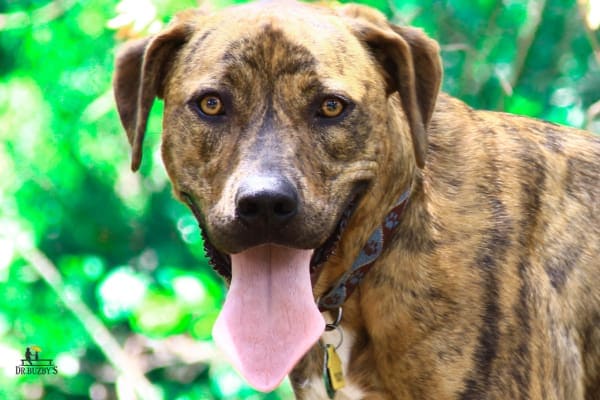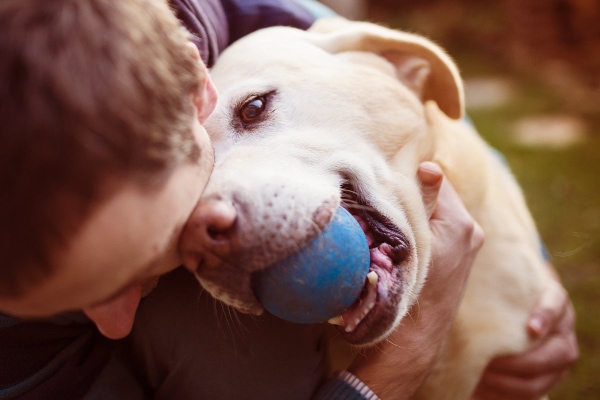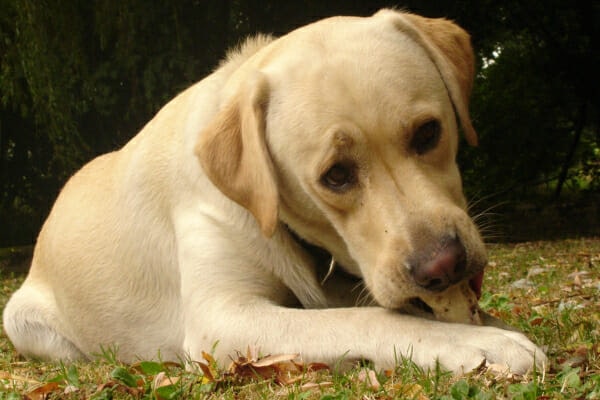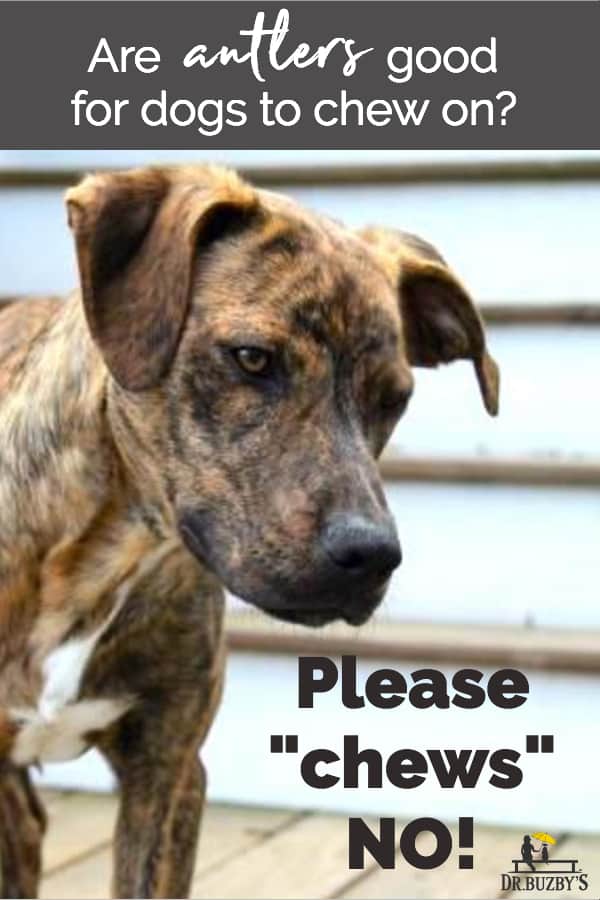Your canine companion may love chewing on antlers. But are antlers safe for dogs? Integrative veterinarian Dr. Julie Buzby shares why her answer (and the answer of most other vets) is a resounding, one thousand percent, “No.”

Have you ever had one of those moments where what you know and what you actually do in real life don’t align? That’s what happened to me the day I gave my dog, Luke, a deer antler to chew. A client had given me the antler because her dog wouldn’t go near it.
But my dog, who must be part T. rex in his ancestral heritage, was more than happy to chomp the antler. And, from the look on his face, he’d probably have answered the question, “Are antlers safe for dogs to chew?” with a happy grin.
Like many dog moms, it brings me great satisfaction to give my dogs something that they enjoy. As an integrative veterinarian, I know what every pet owner knows to be true: What brings my dog satisfaction isn’t necessarily what’s best for him—even if trade magazines, product popularity, or social media would suggest we think otherwise.
Please learn from my own moment of weakness and “chews” to say no to antlers for dogs! Let me explain why my stance on dogs chewing on antlers is so clear by diving into the types of antler chews, why they are on my list of chew toys to avoid at all costs, and how antlers can fracture (break) a dog’s teeth. Then learn safer alternatives and how to determine whether a dog chew toy is too hard for your dog to chew.
- Types of antler chews
- Is it ok for dogs to chew antlers?
- Are antlers safe for dogs?
- 1. Antlers pose a dental risks for dogs.
- 2. Antlers may pose a choking hazard.
- 3. Antlers may cause a GI obstruction.
- What are some safe alternatives to antler chews?
- What do vets recommend dogs to chew on?
- The bottom line: 3 life lessons I hope you'll learn from my experience
- A word of wisdom about antlers
- Partner with your vet and say "no" to antlers
- What chew toys do you give your dog?
Types of antler chews
First, there are many types of antler for dogs on the market. If you walk into a pet store or if you shop online, you’ve probably seen countless antler chews in all sizes and shapes. Deer antlers, the antler that I regretted giving my dog, are probably the most popular. Other types of antler chews include elk antlers, moose antlers, buffalo horns, and split antlers (those that are split in half lengthwise).
The marketing hype surrounding antlers would have us believe that since these types of chew toys are natural dog “treats” that means they are safe for dogs. Sure, they are natural, since they are from an animal. And you can’t argue that they aren’t sustainable since deer, elk, and moose naturally periodically shed their antlers.
But no matter whether it’s a moose antler, buffalo horn, reindeer antler, or split antler, the answer to whether you should give it to your dog is the same…No. No. No. No.

Is it ok for dogs to chew antlers?
Despite the fact that they are natural and sustainable and dogs love chewing on antlers, deer or elk antlers (or any other antlers) are certainly not safe for dogs. And it is not ok for dogs to chew on antlers. End of story.
And this isn’t just my stance because my own dog fractured four teeth during his hour of antler-chewing. In a recent informal poll of over 1,000 veterinarians:
- 93% did not recommend letting dogs chew on antlers
- 6% indicated they educate clients about the potential dangers of antlers but don’t recommend against them and would give them to their own dog
- Less than 1% said they were fine with dogs chewing on antlers
It’s worth noting that several veterinarians commented that they had previously been aligned with the thinking of the 6% in the poll. But after their own dog fractured a tooth (or teeth) chewing an antler, they had changed their stance. Frankly, that’s my story too!
Read on to learn why I (and countless other veterinarians) are vehemently opposed to giving dogs antlers as a chew toy.
Are antlers safe for dogs?
It is a myth that antlers are safe for dogs. Antlers are NOT safe for dogs in any way, shape, or form. Regardless of how they are cut or if they come from a moose, deer, buffalo, reindeer, etc., antlers pose a hazard for dogs for three reasons:
- Antlers can cause painful fractured teeth.
- Smaller antler pieces could pose a choking hazard.
- Ingested pieces of antler chews can cause an obstruction, which may require surgery.
Still unsure? Let’s dive into each of these three very real hazards for dogs.

1. Antlers pose a dental risks for dogs.
If you are a parent to a dog who is an aggressive chewer, it would be easy to see an antler and think “Wow! Finally something my dog can’t chew up in seconds!” Antlers are hard, which means they would hold up fairly well to strong chewing. However, dogs can break deer antlers. In some cases the antler may splinter or the dog may be able to break small pieces off. And deer antlers can break a dog’s teeth.
Dogs don’t have a lot of enamel on their teeth and they can fracture them easily. Therefore, chewing on extremely hard objects like antlers can quickly break a chunk off of your dog’s tooth.
Tooth fractures are a very real problem in dogs. In fact, a study found that one in four animals presented for a dental cleaning have a traumatic dental injury. And 50% of those injuries are fractured or broken teeth.
This statistic isn’t surprising to me. As an integrative veterinarian for over 25 years, it’s not uncommon for me to discover a cracked or broken tooth incidentally during a routine head-to-tail physical examination.
Antlers can cause painful slab fractures
Any tooth in the mouth can fracture, become loose or damaged, or have associated gum problems. But the most common tooth to fracture due to hard dog chews is the fourth upper premolar (i.e. carnassial tooth). If you lift up your dog’s top lip from the side and retract that lip gently up and back, you’ll see a particularly large upper tooth. That’s the fourth upper premolar.
Picture your dog’s fourth premolar like a big iceberg. Now picture a slab of that iceberg falling into the ocean. That’s kind of like a slab fracture—the kind of fracture that commonly happens to a dog’s tooth when he or she chews something that is too hard. The side of the tooth breaks off and you’re left with a raw, exposed flat side.

A slab fracture of your dog’s tooth can cause
- Pain (because the nerve endings are directly exposed)
- Bleeding
- A dog tooth root abscess which may rupture through the side of your dog’s face
- Dental disease in dogs
A broken tooth is trouble in the making because it removes the enamel—the natural sealant that protects the tooth from infection. Without the enamel, infection can wick up the tooth and into the roots.
This may cause a tooth root abscess. (If you’ve ever had an abscessed tooth, you know that it’s excruciatingly painful and can become very serious.) And even if an abscess hasn’t formed yet, chewing on a fractured tooth with an exposed nerve is still extremely painful for your dear dog.
Any potential “teeth cleaning” benefits of antlers are outweighed by the risks
Proponents of antlers argue that chewing on the antler can help clean your dog’s teeth by scraping the tartar off. Sure that might be true. But if your dog cracks a tooth (or teeth) in the process, he or she will end up with bigger dental issues. Plus, there are a myriad of safe and effective ways to keep your dog’s teeth clean at home that don’t run the risk of also fracturing the very teeth you are aiming to protect.
2. Antlers may pose a choking hazard.
The dental concerns with antlers are definitely the biggest reason that I am anti-antler. However, it is also worth mentioning that antlers chewed small may pose a hazard. Anything that can be chewed down to a small piece may cause true choking (obstruction of your dog’s windpipe) or esophageal obstruction (which some people also call choking).
True choking (obstruction of the windpipe) from antlers
A dog choking, while uncommon, can be life-threatening if your dog can’t get enough oxygen. If you see signs of choking, such as gasping for air or making raspy sounds, pawing at the mouth, acting distressed, turning pale or blue, or collapsing, it is important to act quickly.
Remain calm, rapidly assess your dog, then perform the Heimlich maneuver or eXternal eXtraction technique (XXT). Once you have dislodged the object, or if you are not successful after a few attempts, head to the nearest veterinary hospital or emergency clinic for an emergency vet visit.
Esophageal obstruction from an antler piece
Next, let’s take a look at the hazards of an esophageal obstruction. If your dog attempts to swallow a piece of the antler, it could get stuck in the esophagus. This would keep other food from being able to reach the stomach. And it can also damage the walls of the esophagus. In severe cases, the esophagus could get a hole in it, which would allow the contents of the esophagus to leak into the neck, chest, or abdomen.

Thus, is important to be aware of the signs of an esophageal obstruction. They include:
- Swallowing abnormally hard or more frequently
- Acting like it is difficult to swallow
- Regurgitating (i.e. bringing up undigested food without retching)
- Drooling excessively (the dog might keep licking his or her lips)
- Gagging or retching (trying to get something out of throat)
If your dog is showing these signs, contact your veterinarian immediately. Be able to tell your vet if any of your dog’s toys are missing or you suspect he or she may have chewed an antler or other toy down to a small piece then tried to swallow it.
Management of esophageal obstructions
If your dog does have an antler stuck in the esophagus, endoscopy is the safest way to remove it. Some veterinary practices have an endoscope (a flexible tool with a light and camera). But other clinics may refer you to a veterinary specialist near you for the procedure.
Endoscopy typically requires brief general anesthesia. Complications of an esophageal obstruction (and removal) include irritation of the esophagus, esophageal perforation (i.e. hole), and esophageal stricture (i.e. scar tissue that narrows the esophagus). Antlers aren’t worth that risk in my book.
3. Antlers may cause a GI obstruction.
If a dog swallows a chunk of antler, and it makes it past the esophagus, it could also get stuck in the stomach or intestines.

In severe cases, an intestinal obstruction can cause a portion of the intestine to die. Or the piece of antler could create a hole in the intestine. This may allow intestinal contents to leak into the abdomen. Dogs with dead intestines or holes in their intestines are very sick and sometimes die.
GI obstruction is an emergency and requires surgery to remove the antler (and possibly part of the intestine if it is damaged). Complicated or severe cases may require a several-day hospitalization and intensive care. And some obstructions are even fatal.
Symptoms of a GI obstruction
Signs of an intestinal or stomach obstruction include:
- Vomiting
- Abdominal pain
- A lethargic dog
- Poor appetite (or sometimes still a good appetite but vomiting shortly after eating)
- Weight loss
A variety of conditions, including other GI problems like pancreatitis in dogs, and systemic problems like organ failure can also cause these signs. So they are not specific for an obstruction. Whenever you see these signs, call your vet promptly so he or she can assess your dog and make a plan.
Can a dog’s stomach break down antlers?
The short answer is—maybe or maybe not, so it simply isn’t worth the risk. There is some debate among veterinarians on whether a dog’s stomach acids can break down antlers.
However, even if the antler will eventually break down, it can still cause problems while it is intact. The antler could block food from leaving the stomach. Or it could lodge somewhere in the intestines and prevent intestinal contents from moving through. Thus, it is best to just stay far away from them.
What about antlers for dogs with pancreatitis?
Additionally, while I’ve seen antlers advocated as a good low-fat chew for dogs with pancreatitis, the risks still outweigh any potential benefits. If your dog has pancreatitis and you are looking for a low fat chew option, I’d much rather have you pick a safer option (as discussed below).
What are some safe alternatives to antler chews?
Now that you have the facts about antlers for dogs, you may be wondering what is safe for dogs who like to chew or who are heavy chewers. The good news is that you can prevent a painful tooth fracture by choosing the right chew toy. Even better, determining whether a chew toy is too hard for your dog is not complicated. I learned the following rule from Dr. Fraser Hale, a board-certified veterinary dentist:
If a chew toy or bone is too hard to smack into your own kneecap, then it’s too hard to give your dog to chew.
The “kneecap smack” rule of thumb limits what your dog should be chewing. I understand that for dog owners whose canine companions are heavy chewers, this can be frustrating. However, following this rule can also limit the suffering and pain your dog experiences from a fractured tooth.
What do vets recommend dogs to chew on?
I have a short list of safe chew toys for dogs that I recommend to my veterinary clients including Kong toys and Zogoflex toys by West Paw. Or you can look for the Veterinary Oral Health Council seal of acceptance. The VOHC-approved products are safe for dogs and are great for plaque and tartar control, so it is a win-win situation.
What other hard chew toys should I avoid?
In addition to deer antlers, elk antlers, split antlers, and antlers of all types, for your dogs safety, avoid chew toys that don’t pass the “kneecap smack” test. These include:
- Nylon bones
- Large rawhides
- Hooves
- Pig ears
- Bully sticks
- Non-processed large bones
The bottom line: 3 life lessons I hope you’ll learn from my experience
In a moment of weakness, I gave a deer antler to my dog to chew. I’m sad to say it. However, I hope that by sharing my experience, you’ll learn these three life lessons:
- Learn from my mistake. Don’t be fooled by marketing gimmicks that sing the praises of antlers for dogs. My dad always said, “The wise man learns from his mistakes and the wiser man learns from the mistakes of others.” I knew the kneecap rule when I gave my dog the antler. But for some reason, popularity of the commercial market, the advertisements in trade journals, and the fact that antlers are “natural” also factored into the equation. Which brings me to life lesson number two…
- Just because it’s natural doesn’t mean it’s good for your dog. By giving my dog an antler I’d made him as happy as a clam at high tide. However, within an hour, he’d fractured four teeth. I looked at his broken teeth and immediately recognized what had happened.
- Be your dog’s biggest advocate and lean on your trusted sources. After my dog’s short-lived antler experience, I reached out to a trusted group of board-certified veterinary dentists and asked for their opinions on antler chews for dogs. Here is what I learned:
Veterinary dentists unanimously (there was not one dissenter) agreed that antlers are a sure-fire way to fracture a dog’s teeth.
A word of wisdom about antlers
As you are contemplating whether or not to give your dog antlers to chew on, I want to leave you with this quote from veterinary dentistry resident Dr. Emily Baldwin:
“Every dog who ever chewed an antler didn’t absolutely fracture a tooth. However, every person who drives a car doesn’t get in an accident either. We know that this is a risk every time we get in a car, just like we know chewing antlers risks tooth fractures. If tooth fractures are a risk you are willing to assume, then letting your dog chew antlers is an acceptable decision. But know that if a tooth does fracture, you will likely be faced with the choice of extraction vs. root canal.”
Partner with your vet and say “no” to antlers
As your dog’s biggest advocate, I urge you to partner with your veterinarian as a trusted source of information. You have the common goal of protecting the health and happiness of your dog for a long time. Additionally, it is my passion and my mission to help you help your dog live the happiest, healthiest life possible. I’ll do my personal best to share information that helps you make informed choices in the best interest of your dog.
Finally, please make selecting safe chew toys an important part of your dog’s dental care routine along with brushing your dog’s teeth and annual dental exams. What you give your dog to chew really does matter. While antlers might sound like a good idea, the stakes are just too high. Protect your dog’s teeth and digestive tract by “chewsing” to say “no” to antler chews for dogs.

What chew toys do you give your dog?
We’d love to hear. Please comment below.



this article was very helpful, however, I’m still confused as to what I can give my dog that
is truly safe and beneficial. Help me please.
Hi Don,
There is a difference between treats that are safe (low risk of causing dental damage) and products that actually help with dental care maintenance and health. If you are looking for ways to help keep your dog’s teeth clean and healthy, here is a link to the updated list of approved products provided by the Veterinary Oral Health Council: https://vohc.org/wp-content/uploads/2025/02/VOHCAcceptedProductsTable_Dogs-02.07.2025-1.pdf
Hoping this helps a bit. Take care and keep up the good work!
Hi Dr. Buzby, I have a cockapoo that makes whining noises after he eats. It happens almost every time. He has been to the vet multiple times for this and it was recommended to give him gas drops. That works sometimes. I’m just hoping you may have come across this problem before and could offer a solution. I know it’s hard without examining him but he has been examined many times without any problems. He also chews on something after he eats like a chew toy which seems to help a little with his whining. Thank you. Dr. Cardillo.
Hi Dr. Cardillo,
I understand your concern for your pup with this strange whining behavior he exhibits after eating. I wish I had some great advice but unfortunately am just as puzzled as you and your vet. Initially I was suspicious about a painful or cracked tooth. But with him chewing on something after he eats and that helping to alleviate the issue, I am not sure. It makes me wonder if the behavior would stay consistent even if you change up other factors surrounding mealtime such as: offering wet food instead of dry, feeding him in a different room or in a crate, let him outside immediately after eating, etc. I am afraid I lack any real advice but applaud you for advocating for your dog’s health and well-being. Hoping some answers will come to light and wishing you both nothing but the best!
Thank you for the article! I will look into these safe toys. I currently will put peanut butter and kibble into a marrow bone and freeze them to reuse it. I am rethinking that practice. I also have Kongs that i do the same thing with and will probably add to the Kong collection.
By the way, what is the breed of the brindle dog in the article? It is beautiful! I have 2 curs and this looks like one!
Hi Karen,
I am glad the article was informative and helpful. Thank you for the great feedback! I think utilizing Kongs is a great idea. I too have filled them with peanut butter and kibble but also put some yogurt in them to freeze as well. The pup in the picture was just a mixed breed boy. He sure is handsome though and I’m sure yours are as well. ♥ Best wishes and take care!
THANK YOU so much for the article. I should know better after being in pharmacy and the misleading front of the product ‘claims’ and buzz words that makes one assume something totally different than the reality of what the product is made of and/or contains. I’m giving my dog a home remedy as directed by my vet for excessive drooling after ingesting a wild antler. I’ve yet to have an issue from the ones sold on amazon (which the ones i ordered are sanitized or washed at minimum). However my dog picked up a wild antler and who knows what was on the surface (or internally! I will forgo antlers of any kind now, and find a sufficient substitute that’s recommended by the Veterinary Oral Health Council at the link you provided: http://www.vohc.org/VOHCAcceptedProductsTable_Dogs.pdf
Thanks again!
Hi Rhonda,
Thank you for the positive feedback about the article. I appreciate you taking the time to leave a comment and tell your story. Best wishes to you and yours!
Sadly, we just learned this lesson the very hard way. our dog is 11. for her entire life, I had been giving her antlers and bones. I pride myself on her great health and energy and feed her a raw, organic duet. She is lively and a great dog. She loved the antlers and chews. but in the last four years or so, she stopped chewing antlers and even walking away from finishing nohide bones.. I didn’t think much about it until a few weeks ago, when I found a canine tooth on the floor! Long story short, yesterday we were scheduled for a dental procedure with a board certified veterinary dentist. During the procedure, he called us into a room to show us her X-rays and photos, including a video of one of her teeth literally hanging by a thread.. He informed us that she had so many broken and fractured teeth that there was tooth absorption. They had to extract several teeth. He said wild dogs and wolves never touch bones or antlers. Domesticated dogs are bored, he told us, and antlers and bones taste good. Our dog did well with the procedure but he told us he thought she’d been in pain and that many of these were not recent injuries. I will take to my grave extreme guilt over this because I have always been very confident in my dog knowledge. All of my family dogs growing up had rawhide chews. You really have to consider their teeth. You really have to consider facts. Many regular vets we have had have complimented her white teeth!!! Lesson learned, but it was a hard one. And now she has to have soft food for two weeks.
Hi Andrea,
Thank you for the update on your girl! I am sorry she had so many dental fractures and issues once the specialist was able to do a comprehensive oral evaluation. At least you have this behind you and now you know how to prevent future problems. I am glad the procedure went well, and your pup is recovering at home. Thank you for sharing your story with our readers as this may help someone else in a similar situation. Best wishes for a quick recovery.
I stopped giving my Chihuahua deer antlers about a year ago. He is seven and now I give him the Himalayan ones. They say they are digestible but after reading all of these comments and your article I am concerned now. What is your opinion?
Hi Leslie,
I was not familiar with Himalayan treats and had to do some research. It seems they are made of a hardened cheese product. Since I have never seen them for myself, I am not sure if they are too hard or would cause an issue with your dog’s teeth. Your best bet is to take them with you the next time you see your vet and get their opinion. Even if the treats are digestible, if too hard there is a risk of fracturing a tooth.
(Posting once more – with the direct product links, thanks!)
Hi,
Thank you so much for sharing such vital information about dog bones, truly appreciate the knowledge!
Can you please give your opinion on the below chew bones, it’s so hard to get an honest opinion.
I have a 50lb pit mix that LOVES to chew on bully sticks, antlers, other bones – all which I have taken away and only put down rubber toys.
Would these below bones be okay or are they all still too hard?
https://www.amazon.com/gp/product/B01H507S7A/ref=ppx_yo_dt_b_search_asin_title?ie=UTF8&psc=1
I put turkey bread in this bone and then put stuff chicken jerry into each end as a “stopper” to make it challenging for her to get to the Turkey – she loves doing it, it keeps her busy, but can she break her teeth on the bone in an effort to get to the Turkey? It’s very hard and after reading your article, I’m no longer giving it to her
https://www.amazon.com/gp/product/B0828NHD3S/ref=ppx_yo_dt_b_search_asin_title?ie=UTF8&psc=1
https://www.amazon.com/dp/B008A3TE8I?psc=1&ref=ppx_yo2ov_dt_b_product_details
https://www.amazon.com/dp/B07FQFM6LM?psc=1&ref=ppx_yo2ov_dt_b_product_details
Hi Eja,
From what I can tell, these bones may all be too hard. Have you tried Kong products? They have many different styles, and some can be filled with treats and such to keep your dog busy. Here is a link to another article that you may find helpful: Safe Chew Toys for Dogs: Vet-Recommended Tips to Help You “CHEWS” Wisely
Best wishes!
Thank you so much, I’ll check it out!
In the section on pancreatitis, it says “the risks still don’t outweigh any potential benefits.” I think it should say the risks do outweigh potential benefits. Or the benefits don’t outweigh the risks. Correct?
Hi M,
Yes! Good catch! I’ve passed this along to the blog editing team for correction. Thank you so much!
I appreciate your information regarding antlers.
I am confused of what to give my miniature poodle to chew. She is a rescue, his teeth have plaque and horrible breath. I try brushing as often as possible.
So— he will not munch on Kongs. Why??
They taste terrible— a nasty rubber taste. I was curious and tasted it. I am trying to locate an address for the makers of Kong. It seems unsafe for dogs to chew on a product made with chemicals. What do you think?
Thank you.
Hi T K,
The Kong toys do taste like rubber because they are made from natural rubber and are considered “chemical free”. Unfortunately, not every dog will want to chew a rubber product. If you are looking for alternatives, I suggest reading through the approved products list on the Veterinary Oral Health Council’s website:
Our Dogue de bourdeax just had an anter. She knawd on it nightly, grinding her teeth on it, for about a week until I discovered maggots on the inside of the antler! We immediately threw the antler out but my concern now is for my dog. Will this make her sick if she injected any maggots?
Hi Tammie,
Yikes, I bet that was quite a shock! I am glad you were able to get rid of it before your pup ate the whole antler. I know maggots are gross but ultimately, I don’t think they are any more of a concern than other bugs. If you have any concerns or start noticing something different with your dog, I recommend you call your vet and let them know. Good luck!
My German Shepherd is 5 years old and her teeth are uniformly worn down . Trying to convince my husband to stop giving her antlers. I will check out the alternatives you suggest. thanks! Makes a horrible sound when she is chewing and I was thinking her teeth might be getting worn instead of the antler!
Hi Mary, Yes, sadly I agree with your concerns 100%. Unfortunately, there may be major dental work in your dog’s future, but in the meantime, you definitely need to help your husband understand the risks. Great job being proactive! 🙂
I have never given my dogs deer antlers after studying the differences in appearance and hardness with elk antlers, the latter which has been fine. Very familiar with my dogs chewing habits though, they’re under 20 pounds, and thankfully, they’re not very aggressive chewers either. They love raw lamb shanks the most, and one can keep them busy for a week.
I think the gist of your article is just to be aware of your dog’s chewing habits and make decisions based off of that
Thanks for the comment. I personally know dogs who have fractured teeth on elk antler, so I advise clients against all antler. This is also the position of the American Veterinary Dental College. You are absolutely right that certain dogs are more aggressive chewers than others, but giving a dog an antler to chew is just not a risk I would take.
What about puppies? Antlers or Kong’s?
No antlers ever, Don, in my opinion. I like Kongs for dogs of all ages, including puppies. 🙂
Appreciate the guidance…my question then is what DO you recommend. I’ve had some vets recommend elk antlers, nylabones, rawhide, bully sticks, Himalayan chews, Kongs…and other vets say that those are terrible choices. What are the “safe” options?
Great question, Lori. Although I must offer the disclaimer that any toy or chew you give your dog should be enjoyed under “parental supervision”, here is my list: Planet Dog rubber dog toys, Kongs, GoughNuts chew toys, and Zogoflex dog toys by West Paw. Hope this helps!
My American Staffordshire Terrier loved to chew. We’ we’re very careful only to give him Nylabones. We thought they were a good alternative to antlers etc. Well, about two years ago he had a slab fracture. The fracture was not bad enough to remove the tooth as he was nine years old at the time. We continued to keep his teeth clean with brushing but the area around that fracture tended to bleed. The vet kept her eye on it until 2 months ago when he developed a leison on his gum further back on his jaw.
Got the awful news it was osteosarcoma. We lost our beautiful boy within four weeks of the diagnosis.
Osteosarcoma in the jaw is rare. It is mainly due to genetics and we understand that. But, it seems very coincidental it happened near that slab fracture. If we ever get another dog, which I cannot even imagine right now, nothing hard to chew.
Dr. would you think the trauma to the tooth could have caused osteosarcoma.?
Hello Janet,
I’m so very sorry to hear of your loss of your boy. You bring up an interesting question, and one that I can’t find documented in the scientific literature, particularly for osteosarcoma, but I do know that “trauma” and “chronic inflammation” can be triggers for cancer in certain circumstances. I’m guessing yours was strictly coincidental, so no mom guilt allowed. 🙂 Thank you for your comment.
I am so pleased you have published this article!!! I have been arguing about the safety of Deer/Elk chews for the past 4 years and been verbaly abused and told I know nothing, on the contrary, like you I have seen the damage these chews can do, both to our beloved canine companions and our pockets via the vet bills to treat the fall out. Well done
Thanks, Tracey. I appreciate your words of support. I am frankly amazed that these products persist on the market. I see pictures all the time in my online veterinary groups of broken teeth from these and similar products. It’s a major issue for dogs!
Great advice! I learned the hard way after adopting a jack russell who is a much stronger chewer than my other dogs have been. A dental exam revealed two fractures in teeth which were subsequently extracted. I thought I was doing the right thing by giving him “safe” bones to keep him occupied and keep tartar down, but I hadn’t considered the possibility of fractures. We stick to softer things now!
Hi Vicki! Thanks for your comment. I wish more people were aware of the hazards that we had to learn the hard way! Please help me get the word out for dog owners about these risks. Thanks!
Yup, that is exactly happened to my standard poodle – I did’nt notice it until I was brushing her teeth later and that TOOTH bled – not the gum the tooth! Why do they keep selling these things! I thought it was just my dog that had an issue.
Thanks for your comment, Colette. I know exactly what you mean by the tooth bleeding, and this is extremely painful for the poor dog. I’m so sorry to hear that you and your dog had this experience. I don’t know the answer to your question, but I wholeheartedly agree with your sentiment. We live in a country that seems to be very safety conscious, but we’re failing our dogs on this one.